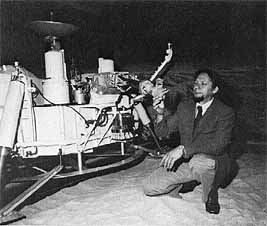- [396] Viking Surface
Sampler
-
- The Viking lander's
chemical and biological investigations all used
samples of surface materials excavated by the surface
sampler In addition, as the experience with lunar
Surveyor spacecraft demonstrated, there was much to
learn about the surface simply by digging in it. In
the Viking mission, digging was part of the physical
properties and magnetic properties
investigations.
-
- The surface sampler
consisted of a col rector head attached to the end of
a three-meter retractable boom. The arm housing the
boom could be moved both horizontally and vertically.
The boom itself was constructed from two ribbons of
stainless steel welded together along the edges. When
extended, the two layers opened to form a rigid tube.
When retracted, the boom flattened. A flat cable
sandwiched between the boom layers transmitted
electrical power to the collector head.
-
- The collector head was
basically a scoop with a movable lid and a backhoe
hinged to its lower surface. Where the scoop is
attached to the end of the boom, a motorized rotator
acted as a mechanical wrist to permit manipulation of
the collector head. To fill the scoop, the lid was
first raised and then the boom was extended along or
into the surface. Once full, the lid closed. The top
of the lid had holes two millimeters in diameter,
which formed a sieve. When the collector head was
positioned over one of the inlets for the instruments,
it was inverted and vibrated. Only particles smaller
than two millimeters were delivered to the instrument
inlets. Coarser samples could be delivered to the
x-ray fluorescence spectrometer, if desired. The gas
chromatograph-mass spectrometer and the
biologyinstruments had their own filters to control
the size of material introduced into their sample
processing assemblies.
-
- The surface sampler could
also dig trenches, by lowering the backhoe to place
the sampler head on the surface, and then retracting
the boom. Excavated materials could be scooped up for
sampling. A brush, magnets, temperature sensor, and
other instrumentation also provide data concerning the
physical properties of the materials.
|
















